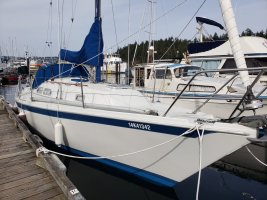Frank Langer
1984 Ericson 30+, Nanaimo, BC
Hi,
This problem has me and the factory techs at Raymarine stumped, so I really need some good advice.
My ST40 wind instrument began showing erratic readings, then fixed itself, but after a few more day sails, the wind gradually reduced to zero on the display, although the wind vane was spinning freely.
The Raymarine tech said the small circuit board in the mast top had failed. I found a replacement in England, worked through a challenging installation, and it worked as normal for about 6 day sails. Then the display went from normal wind speed to gradual reduction to zero over ten minutes, first the apparent wind, then the true wind, with both eventually showing zero.
Raymarine tech said my display circuit board had failed, no longer interpreting the signal from the mast head correctly.
I found a replacement display on ebay, and on installation the display appeared to show correct wind speed for about five minutes, then both apparent and true wind went back to zero.
So I know the wind vane is turning freely at the mast head, the mast head circuit board is connecting to the display at the pedestal (it shows dashes, not zero, when not connected) and the display is getting power.
Raymarine techs then had me check power to the unit power source (12.59 volts), then showed 11.22 volts at the display itself, 6.8 at the wires coming from the mast head (tech said it should be 6 to 7 volts, so ok). At that point he gave up, no further advice and they don't service these any more.
Today I turned it on again, and it appeared to show proper wind speed, both true and apparent, for about a minute, then both numbers returned to zero.
The only parts to this system are the spinning wind vane, the mast head circuit board, the wire running down the mast to the display, and the display. The mast head circuit board and display are new. I did have to lengthen the wire at the mast head by a foot to make a proper connection. These wires are tiny, about 22 awg and the foot length I added is 16 awg as I couldn't get 22 awg at the time. I crimped on the extra foot with good ratchet crimps, and soldered that new wire to the mast head circuit board.
I have no idea why I'm getting zero on the display, or what I can do to restore proper wind speed readings.
A new wind instrument is really expensive, and most require running a new wire down the mast, which means raising the mast cause its deck stepped and not accessible at deck level without raising the mast.
I would appreciate any thoughts or advice you may have.
Frank
This problem has me and the factory techs at Raymarine stumped, so I really need some good advice.
My ST40 wind instrument began showing erratic readings, then fixed itself, but after a few more day sails, the wind gradually reduced to zero on the display, although the wind vane was spinning freely.
The Raymarine tech said the small circuit board in the mast top had failed. I found a replacement in England, worked through a challenging installation, and it worked as normal for about 6 day sails. Then the display went from normal wind speed to gradual reduction to zero over ten minutes, first the apparent wind, then the true wind, with both eventually showing zero.
Raymarine tech said my display circuit board had failed, no longer interpreting the signal from the mast head correctly.
I found a replacement display on ebay, and on installation the display appeared to show correct wind speed for about five minutes, then both apparent and true wind went back to zero.
So I know the wind vane is turning freely at the mast head, the mast head circuit board is connecting to the display at the pedestal (it shows dashes, not zero, when not connected) and the display is getting power.
Raymarine techs then had me check power to the unit power source (12.59 volts), then showed 11.22 volts at the display itself, 6.8 at the wires coming from the mast head (tech said it should be 6 to 7 volts, so ok). At that point he gave up, no further advice and they don't service these any more.
Today I turned it on again, and it appeared to show proper wind speed, both true and apparent, for about a minute, then both numbers returned to zero.
The only parts to this system are the spinning wind vane, the mast head circuit board, the wire running down the mast to the display, and the display. The mast head circuit board and display are new. I did have to lengthen the wire at the mast head by a foot to make a proper connection. These wires are tiny, about 22 awg and the foot length I added is 16 awg as I couldn't get 22 awg at the time. I crimped on the extra foot with good ratchet crimps, and soldered that new wire to the mast head circuit board.
I have no idea why I'm getting zero on the display, or what I can do to restore proper wind speed readings.
A new wind instrument is really expensive, and most require running a new wire down the mast, which means raising the mast cause its deck stepped and not accessible at deck level without raising the mast.
I would appreciate any thoughts or advice you may have.
Frank


